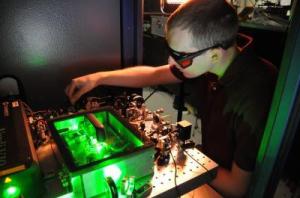C reative
Particle
Higgs
CPH Theory is based on Generalized light velocity from energy into mass.
CPH Theory in Journals
|
A Quiet Phase: Optical Tools Produce Ultra-Low-Noise Microwave Signals
|
|
A Quiet Phase: Optical Tools Produce Ultra-Low-Noise Microwave Signals
ScienceDaily (June 27, 2011) — By combining advanced laser technologies in a new way, physicists at the National Institute of Standards and Technology (NIST) have generated microwave signals that are more pure and stable than those from conventional electronic sources. The apparatus could improve signal stability and resolution in radar, communications and navigation systems, and certain types of atomic clocks.
Matt Kirchner, a University of Colorado graduate student, fine-tunes an ultra-stable microwave generator that he helps operate at NIST. (Credit: Burrus/NIST)
Described in Nature Photonics, NIST's low-noise apparatus is a new application of optical frequency combs, tools based on ultrafast lasers for precisely measuring optical frequencies, or colors, of light. Frequency combs are best known as the "gears" for experimental next-generation atomic clocks, where they convert optical signals to lower microwave frequencies, which can be counted electronically. The new low-noise system is so good that NIST scientists actually had to make two copies of the apparatus just to have a separate tool precise enough to measure the system's performance. Each system is based on a continuous-wave laser with its frequency locked to the extremely stable length of an optical cavity with a high "quality factor," assuring a steady and persistent signal. This laser, which emitted yellow light in the demonstration but could be another color, is connected to a frequency comb that transfers the high level of stability to microwaves. The transfer process greatly reduces -- to one-thousandth of the previous level -- random fluctuations in the peaks and valleys, or phase, of the electromagnetic waves over time scales of a second or less. This results in a stronger, purer signal at the exact desired frequency. The base microwave signal is 1 gigahertz (GHz, or 1 billion cycles per second), which is the repetition rate of the ultrafast laser pulses that generate the frequency comb. The signal can also be a harmonic, or multiple, of that frequency. The laser illuminates a photodiode that produces a signal at 1 GHz or any multiple up to about 15 GHz. For example, many common radar systems use signals near 10 GHz. NIST's low-noise oscillator might be useful in radar systems for detecting faint or slow-moving objects. The system might also be used to make atomic clocks operating at microwave frequencies, such as the current international standard cesium atom clocks, , more stable. Other applications could include high-resolution analog-to-digital conversion of very fast signals, such as for communications or navigation, and radio astronomy that couples signals from space with arrival times at multiple antennas.
Story Source:
Source: Siencedaly
1 2 3 4 5 6 7 8 9 10 Newest articles
|
|
Sub quantum space and interactions from photon to fermions and bosons |
Interesting articles
Since 1962 I doubted on Newton's laws. I did not accept the infinitive speed and I found un-vivid the laws of gravity and time.
I learned the Einstein's Relativity, thus I found some answers for my questions. But, I had another doubt of Infinitive Mass-Energy. And I wanted to know why light has stable speed?

